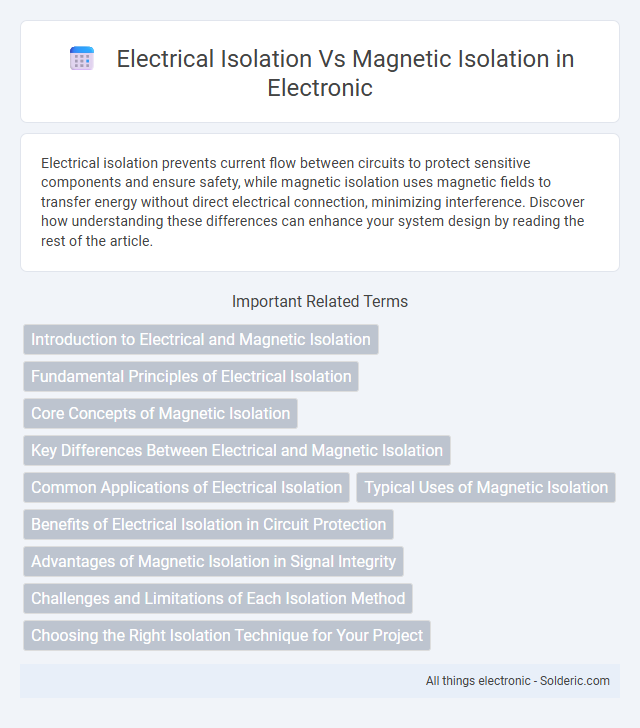Electrical isolation prevents current flow between circuits to protect sensitive components and ensure safety, while magnetic isolation uses magnetic fields to transfer energy without direct electrical connection, minimizing interference. Discover how understanding these differences can enhance your system design by reading the rest of the article.
Comparison Table
| Feature | Electrical Isolation | Magnetic Isolation |
|---|---|---|
| Principle | Breaks electrical continuity to prevent current flow | Uses magnetic fields to transfer energy without direct electrical contact |
| Common Devices | Optocouplers, transformers, isolation amplifiers | Transformers, inductive couplers, isolation transformers |
| Applications | Signal isolation, safety, noise reduction | Power transfer, signal coupling, noise rejection |
| Frequency Range | Wide range, depending on device type | Typically low to mid frequencies, limited by core and winding |
| Isolation Voltage | Typically up to several kV, device dependent | High voltage isolation, often several kV to tens of kV |
| Advantages | Compact size, precise signal isolation, minimal leakage | Robust power transfer, galvanic isolation, high voltage handling |
| Limitations | Limited power handling, slow response for optical devices | Size and weight, limited bandwidth, core saturation risk |
Introduction to Electrical and Magnetic Isolation
Electrical isolation involves separating electrical circuits to prevent current flow and protect against electrical shocks, ensuring safety and signal integrity. Magnetic isolation utilizes magnetic fields through transformers or inductive couplers to transfer signals or power without direct electrical connection, reducing interference and ground loop issues. Understanding your system's requirements for noise reduction and safety helps determine whether electrical or magnetic isolation is the ideal choice.
Fundamental Principles of Electrical Isolation
Electrical isolation relies on the physical separation and use of insulating materials to prevent direct current flow between circuits, ensuring safety and signal integrity. It fundamentally depends on high impedance barriers, such as optocouplers or transformers, to block unwanted electrical paths while allowing intended signal transmission. This separation minimizes interference, protects sensitive components, and helps meet regulatory standards for electrical safety.
Core Concepts of Magnetic Isolation
Magnetic isolation relies on transformers and inductive coupling to transfer energy between circuits while maintaining electrical separation, preventing direct conductive paths and reducing noise interference. The core concept involves a magnetic core that channels the magnetic flux generated by the primary winding to induce a voltage in the secondary winding, ensuring signal integrity and safety. This method excels in applications requiring galvanic isolation, high-frequency signal transmission, and protection against electric shock.
Key Differences Between Electrical and Magnetic Isolation
Electrical isolation prevents direct current flow by using insulating materials to separate circuits, ensuring no electrical continuity, while magnetic isolation transfers energy through magnetic fields without a direct electrical connection. Key differences include electrical isolation's reliance on physical barriers like transformers or optocouplers, versus magnetic isolation's dependence on inductive coupling to block electrical noise and interference. Your choice between them depends on the need for complete circuit separation or efficient energy transfer with minimal signal degradation.
Common Applications of Electrical Isolation
Electrical isolation is commonly used in medical devices, industrial control systems, and communication equipment to protect sensitive components from high voltages and prevent electrical shock. It ensures safety and signal integrity by separating different sections of a circuit without direct electrical connection. Your systems benefit from electrical isolation by enhancing reliability and meeting regulatory standards in environments with high electrical noise or potential voltage surges.
Typical Uses of Magnetic Isolation
Magnetic isolation is commonly used in power transformers, signal isolation in communication devices, and medical equipment to prevent direct electrical connection while allowing energy transfer. It ensures safety by isolating circuits from high voltages and reduces noise interference in sensitive electronic systems. Applications include isolation amplifiers, inductive charging pads, and ground loop elimination in audio equipment.
Benefits of Electrical Isolation in Circuit Protection
Electrical isolation in circuit protection provides enhanced safety by preventing direct electrical contact between high-voltage and low-voltage circuits, reducing the risk of electric shock and equipment damage. It also mitigates noise and interference, improving signal integrity and system reliability in sensitive electronic components. This isolation ensures compliance with regulatory standards and enhances overall system durability by preventing fault propagation.
Advantages of Magnetic Isolation in Signal Integrity
Magnetic isolation offers superior signal integrity by effectively reducing electromagnetic interference (EMI) and minimizing ground loop noise in sensitive electronic circuits. Its ability to provide galvanic isolation through transformers ensures that signal transmission remains clean without direct electrical connection, enhancing noise immunity. This isolation method also supports higher frequency signals with minimal distortion, improving overall communication reliability in industrial and communication systems.
Challenges and Limitations of Each Isolation Method
Electrical isolation faces challenges such as parasitic capacitance and leakage currents that can compromise signal integrity and safety in high-voltage applications. Magnetic isolation, while effective at blocking direct current and providing galvanic isolation, suffers from limitations including core saturation, electromagnetic interference (EMI), and size constraints for high-frequency operations. Both methods require careful design consideration to balance isolation performance, physical size, and noise immunity in complex electronic systems.
Choosing the Right Isolation Technique for Your Project
Electrical isolation prevents direct current flow between circuits by using insulating materials, making it ideal for safety-critical applications and noise reduction in power systems. Magnetic isolation employs transformers or inductive coupling to transfer signals or power without direct electrical connection, offering advantages in signal integrity and galvanic isolation for communication and measurement devices. Selecting between electrical and magnetic isolation depends on factors like voltage levels, signal type, frequency, and system complexity to ensure optimal performance and protection in your project.
Electrical Isolation vs Magnetic Isolation Infographic

 solderic.com
solderic.com